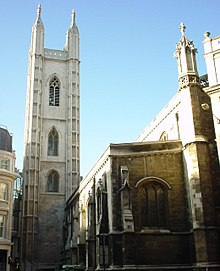St Mary Aldermary
| St. Mary Aldermary | |
|---|---|
 St. Mary Aldermary Church view from Queen Victoria Street | |
 | |
| Address | Bow Lane, City of London |
| Country | United Kingdom |
| Denomination | Anglican |
| Architecture | |
| Architect(s) | Sir Christopher Wren |
| Style | Gothic revival |
Aslar-faced outside and Gothic throughout[1], St Mary Aldermary is an Anglican church in Bow Lane in London.
History
There has been a church on this site for over 900 years and its name is usually taken to mean that it is the oldest of the City churches dedicated to the Virgin Mary. Stow mentioned various dignitaries buried in the early church, in his 1598 Survey of London. These include Richard Chaucer, vintner, a relative of the poet Geoffrey Chaucer.
In 1510, Sir Henry Keeble financed the building of a new church. The tower was unfinished when he died in 1518. In 1629, two legacies enabled it to be completed. The church was said to have been among the largest and finest of the City's churches. The parish registers date from 1558. They are now deposited in the Guildhall Library. John Milton married his third wife, Elizabeth Minshull in this church in 1663.
St Mary Aldermary was greatly damaged in London's Great Fire of 1666[2] although parts of its walls and tower survived. It was mostly rebuilt by Sir Christopher Wren in a Gothic style[3]. The money to rebuild the church was donated in 1679 by Anne Rogers, niece of the Somerset squire Henry Rogers. The church opened in 1682.
According to Pevsner, it is "the chief surviving monument of the 17th century Gothic revival in the City and -- with Warwick -- the most important late 17th century Gothic church in England."[4]
St Mary Aldermary was damaged by German bombs in the London Blitz during the Second World War. ([5]) All the windows were shattered and some plaster fell from the vaulting but the building itself remained intact.
The church has been repaired and restored many times over the years. The latest interior restoration was finished in April 2005, with special attention paid to the plaster ceilings and the memorials on the north wall. A service was held on April 21, 2005 to celebrate the restoration, presided over by Richard Chartres, the Bishop of London. As of April, 2005, the priest in charge of the church was Father John Mothersole.
The church was designated a Grade I listed building on 4 January 1950.[6]
Notes

- ^ "The City of London Churches" Betjeman,J Andover, Pikin, 1967 ISBN 0853721122
- ^ "The Visitors Guide to the City of London Churches" Tucker,T: London, Friends of the City Churches, 2006 ISBN 0955394503
- ^ "The Old Churches of London" Cobb,G: London, Batsford, 1942
- ^ "London:the City Churches” Pevsner,N/Bradley,S New Haven, Yale, 1998 ISBN 0300096550
- ^ "The London Encyclopaedia" Hibbert,C;Weinreb,D;Keay,J: London, Pan Macmillan, 1983 (rev 1993,2008) ISBN 978-1-4050-4924-5
- ^ Historic England. "Details from listed building database ({{{num}}})". National Heritage List for England. accessed 23 January 2009
